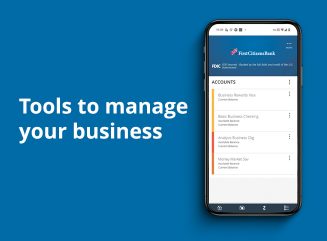Digital banking for business
Seamlessly access all of your accounts from one place with First Citizens Digital Banking for business.

Control your portfolio
Invest how you want, when you want, in real time with Self-Directed Investing.

Digital banking for business
Seamlessly access all of your accounts from one place with First Citizens Digital Banking for business.
See how we're supporting companies
We're committed to serving companies as they expand and succeed. The proof is in our success stories.
Q4 Quarterly Market Review: Available now
The Making Sense team reviews changes in the market during Q4 2025.
A change in leadership is challenging for any organization. It can be particularly difficult for nonprofits, where it's common for a few top employees to hold the lion's share of knowledge, skills and relationships.

Nonprofit succession planning is crucial to avoid these problems. Follow these tips to create a successful plan and avoid putting your nonprofit at risk.
In a nonprofit succession plan, the first step is to identify the most important roles that must be replaced effectively. This could include the executive director, members of the board and high-level staff positions like program coordinators and gift officers. You may want to consider the current turnover risk for each role so you can prioritize planning for those. For example, plan first for employees who are nearing retirement age.
For each role, make a list of what someone would need to handle the job properly. This could include the job expectations, key contacts, goals and an explanation for how the role interacts with other parties at the nonprofit. When you need to replace a staff member, you can use this information both to create a job post and to help onboard the new employee.
From there, start crafting a plan for how roles would transition in the future. Who'd be in charge of the job search? How long do you anticipate the search will take? Will the current staff member stay on to train their replacement? Have a plan in place for both planned departures and emergencies. While real life might not follow your plans exactly, thinking ahead will still make you more prepared.
Developing a nonprofit succession plan isn't a one-person job. For it to be successful, it needs buy-in from the other key stakeholders, because they'll also be responsible for executing the plan.
Bring together a committee of these stakeholders. Include a representative from the board, the executive team and other leadership roles. During the meeting, ask these key questions suggested by Donorbox.org:
Commit to knowledge sharing as well, so others can support a key new team member when they join. In particular, focus on how current employees will help this new hire develop relationships with donors, board members and the rest of team.
During these discussions, make sure you all agree on the vision and long-term goals of the nonprofit, so you can communicate these to new hires. By getting all key stakeholders on the same page for the succession plan, you'll avoid confusion when it comes time to replace an important role.
For many nonprofits, the best option for hiring is from within. Determine your wants and needs for a role, and create a list of employees who could fill it. Develop training and professional development plans for these employees to grow within your organization so that they'll be ready once the time comes. This will help lead to a smoother transition, and it may also reduce turnover, as talented employees will see they have a future at the nonprofit.
In some cases, hiring within may not be possible. For those cases, you should have a clear goal and plans to find a quality candidate. The process can take up to six months. Once you know a board or staff member is leaving, immediately create or update the position's job description to avoid wasting time.
Ideally, whenever a key member of the nonprofit leaves, it's a planned departure, so you have time to find and train their replacement. But there will be times when people leave unexpectedly, such as for health reasons. Your nonprofit succession plan should also include preparations for an emergency transition.
Consider who would cover each important role during your hiring search. Could you fill these gaps with your current staff, or would you need to bring on an outside interim director temporarily for the role? Decide who would be supervising the interim position and how their responsibilities might differ from someone who was permanently filling the role.
The goal is to buy time to conduct your formal replacement search while minimizing disruptions from the surprise departure. Make sure to review your plan annually so that it's updated based on your organization's current needs.
As you develop your succession plan, lay out the necessary training for each role. Bear in mind that there may be an onboarding period of several months. Prepare the training and assessment materials before you begin the search for the role, and make expectations clear in the interviews.
Once you hire someone, you'll want to track how well your new employee is acclimating to your culture. Since these are leadership positions, consider how the board and other key stakeholders will encourage the new hire, so they gain confidence to eventually run your nonprofit. Communicate regularly, and look for ways to make the transition as successful as possible.
Changes in leadership roles are never easy, but nonprofit succession planning can make them more manageable. With a plan in place, your nonprofit can continue serving its mission uninterrupted even after a key member departs.



This material is for informational purposes only and is not intended to be an offer, specific investment strategy, recommendation or solicitation to purchase or sell any security or insurance product, and should not be construed as legal, tax or accounting advice. Please consult with your legal or tax advisor regarding the particular facts and circumstances of your situation prior to making any financial decision. While we believe that the information presented is from reliable sources, we do not represent, warrant or guarantee that it is accurate or complete.
Third parties mentioned are not affiliated with First-Citizens Bank & Trust Company.
Links to third-party websites may have a privacy policy different from First Citizens Bank and may provide less security than this website. First Citizens Bank and its affiliates are not responsible for the products, services and content on any third-party website.

Treasury & Cash Management
Electronic Bill Presentment & Payment
Investment & Retirement Services
Community Association Banking
Equipment Financing & Leasing
Credit Cards
Merchant Services
Email Us
Please select the option that best matches your needs.
Customers with account-related questions who aren't enrolled in Digital Banking or who would prefer to talk with someone can call us directly.